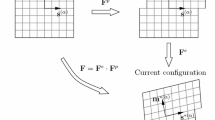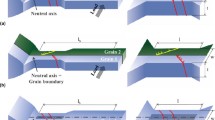Abstract
Miniature cantilevers are associated with amplification in strain gradient and dislocation recovery. These contrasting phenomena interplay to impart strengthening via the injection of geometrically necessary dislocations because of strain gradients and softening due to the surface proximity effect. In this work, creep studies on Al cantilevers of thicknesses ranging from 0.070 to 7 mm demonstrate this interplay. The 2D strain field and dislocation substructure were examined to understand the steady-state creep response in miniaturized cantilevers. The average creep response of the cantilever strengthens with decreasing cantilever thickness; however, regimes of hardening, softening, and bulk-like behavior were observed while traveling along the length of the cantilever. Consistently, refinement in the steady-state dislocation substructure was observed in the regions of large strain gradients. The locations in a miniaturized cantilever with insignificant strain gradients registered surface proximity effect-induced enhanced creep rates. An analytical model has been developed to describe the strain gradient-surface proximity interplay.
Graphical abstract









Similar content being viewed by others
Data availability
The datasets generated during and/or analyzed during the current study are not publicly available but are available from the corresponding author on reasonable request.
Notes
If a bending creep experiment is performed at \(\sigma_{max} < \sigma_{YS}\), where \(\sigma_{max}\) and \(\sigma_{YS}\) are the maximum stress in the cantilever at any time and the yield strength of the material, respectively, then the stress-state, σ, at the stress-invariant points can be given by \(\sigma = My/I\), where M and I are the moment and area inertia, respectively [6].
GND density was calculated by EDAX OIM EBSD software using the default G.N.D. dislocation density tensor (Nye tensor).
This estimate is based on the highest value of the strain gradient prevalent in the bulk-sized cantilevers (i.e., h ≥ 2.5 mm) at a strain of 5% (which is well inside the steady-state creep regime at the stress and temperature range used in this study).
Euler- Bernoulli cantilevers have a length to thickness ratio, i.e., h/L, of ≥ 6, which allows neglecting the shear stresses in comparison to normal or bending stress along the length of the cantilever [3, 4]. The cantilevers in this work are designed to have chamfers on all four sides, which precludes stress concentration at the fixed-end [6, 7], and ensures applicability of the standard beam equations to obtain stress–strain relationships.
Rust-Oleum is a commercial high temperature spray paint manufactured by Rust-Oleum Global, U.S.A.
References
J.-P. Poirier, Creep of crystals (Cambridge University Press, Cambridge, 1985)
M.E. Kassner, Fundamentals of creep in metals and alloys. Elsevier (2015). https://doi.org/10.1016/C2012-0-06071-1
S.I.A. Jalali, P. Kumar, V. Jayaram, High throughput determination of creep parameters using cantilever bending: part I—steady-state. J. Mater. Res. 35, 353–361 (2020). https://doi.org/10.1557/jmr.2020.36
S.I.A. Jalali, P. Kumar, V. Jayaram, High throughput determination of creep parameters using cantilever bending: part II—primary and steady-state through uniaxial equivalency. J. Mater. Res. 35, 362–371 (2020)
ASTM E139-11, Standard test methods for conducting creep, creep-rupture, and stress-rupture tests of metallic materials (ASTM International, West Conshohocken, 2018), p.2018
S.I.A. Jalali, P. Kumar, V. Jayaram, Creep of metallic materials in bending. JOM 71, 3563–3583 (2019). https://doi.org/10.1007/s11837-019-03707-1
SIA Jalali Evaluation of Power-Law Creep in Bending, IISc Bangalore, 2020. http://etd.iisc.ac.in/handle/2005/4547
S.I.A. Jalali, P. Kumar, V. Jayaram, Microstructural equivalence between bending and uniaxial creep. Scr. Mater. 186, 99–103 (2020). https://doi.org/10.1016/j.scriptamat.2020.04.033
S.I.A. Jalali, V. Jayaram, P. Kumar, Creep micromechanics in meso-length scale samples. Acta Mater. 205, 1–32 (2021). https://doi.org/10.1016/j.actamat.2020.116535
S.I.A. Jalali, P. Kumar, V. Jayaram, Customized high-temperature bending with DIC for high-throughput determination of creep parameters: technique instrumentation, and optimization. Jom 72, 4522–4538 (2020). https://doi.org/10.1007/s11837-020-04445-5
T.H. Hyde, W. Sun, J.A. Williams, Requirements for and use of miniature test specimens to provide mechanical and creep properties of materials: a review. Int. Mater. Rev. 52, 213–255 (2007). https://doi.org/10.1179/174328007X160317
N.S. Cheruvu, K.S. Chan, R. Viswanathan, Evaluation, degradation and life assessment of coatings for land based combustion turbines. Energy Mater. 1, 33–47 (2013). https://doi.org/10.1179/174892306X99705
MFM Costa, V Teixeira (2011) Assessment of residual stress on thin films by laser microtopography. 8011:281–287 https://doi.org/10.1117/12.902212
C.P. Frick, B.G. Clark, S. Orso, A.S. Schneider, E. Arzt, Size effect on strength and strain hardening of small-scale [1 1 1] nickel compression pillars. Mater. Sci. Eng. A 489, 319–329 (2008). https://doi.org/10.1016/J.MSEA.2007.12.038
C. Motz, D. Weygand, J. Senger, P. Gumbsch, Micro-bending tests: A comparison between three-dimensional discrete dislocation dynamics simulations and experiments. Acta Mater. 56, 1942–1955 (2008). https://doi.org/10.1016/J.ACTAMAT.2007.12.053
N.A. Fleck, G.M. Muller, M.F. Ashby, J.W. Hutchinson, Strain gradient plasticity : theory and experiment. Acta Metall. 42, 475–487 (1994)
N.I. Tymiak, D.E. Kramer, D.F. Bahr, T.J. Wyrobek, W.W. Gerberich, Plastic strain and strain gradients at very small indentation depths. Acta Mater. 49, 1021–1034 (2001). https://doi.org/10.1016/S1359-6454(00)00378-5
N.A. Fleck, J.W. Hutchinson, Strain gradient plasticity. Adv. Appl. Mech. 33, 295–361 (1997). https://doi.org/10.1016/S0065-2156(08)70388-0
N.A. Fleck, J.R. Willis, A mathematical basis for strain-gradient plasticity theory—Part I: Scalar plastic multiplier. J. Mech. Phys. Solids. 57, 161–177 (2009). https://doi.org/10.1016/j.jmps.2008.09.010
N.A. Fleck, J.W. Hutchinson, A phenomenological theory for strain gradient effects in plasticity. J. Mech. Phys. Solids. 41, 1825–1857 (1993). https://doi.org/10.1016/0022-5096(93)90072-N
J. Rafael Velayarce, C. Motz, Effect of sample size and crystal orientation on the fatigue behaviour of single crystalline microbeams. Materials (Basel) 13, 741 (2020). https://doi.org/10.3390/ma13030741
Y. Huang, S. Qu, K.C. Hwang, M. Li, H. Gao, A conventional theory of mechanism-based strain gradient plasticity. Int. J. Plast. 20, 753–782 (2004). https://doi.org/10.1016/j.ijplas.2003.08.002
W.D. Nix, H. Gao, Indentation size effects in crystalline materials: A law for strain gradient plasticity. J. Mech. Phys. Solids 46, 411–425 (1998). https://doi.org/10.1016/S0022-5096(97)00086-0
J. Nye, Some geometrical relations in dislocated crystals. Acta Metall. 1, 153–162 (1953). https://doi.org/10.1016/0001-6160(53)90054-6
J.A. El-Awady, M.D. Uchic, P.A. Shade, S.-L. Kim, S.I. Rao, D.M. Dimiduk, C. Woodward, Pre-straining effects on the power-law scaling of size-dependent strengthening in Ni single crystals. Scr. Mater. 68, 207–210 (2013). https://doi.org/10.1016/j.scriptamat.2012.10.035
J.A. El-Awady, Unravelling the physics of size-dependent dislocation-mediated plasticity. Nat. Commun. 6, 5926 (2015). https://doi.org/10.1038/ncomms6926
J.S. Stölken, A.G. Evans, A microbend test method for measuring the plasticity length scale. Acta Mater. 46, 5109–5115 (1998). https://doi.org/10.1016/S1359-6454(98)00153-0
A.G. Evans, J.W. Hutchinson, A critical assessment of theories of strain gradient plasticity. Acta Mater. 57, 1675–1688 (2009). https://doi.org/10.1016/J.ACTAMAT.2008.12.012
T.H. Hyde, W. Sun, Some considerations on specimen types for small sample creep tests. Mater. High Temp. 27, 157–165 (2010). https://doi.org/10.3184/096034010X12801645220736
T.H. Hyde, C.J. Hyde, W. Sun, Theoretical basis and practical aspects of small specimen creep testing. J. Strain Anal. Eng. Des. 48, 112–125 (2013). https://doi.org/10.1177/0309324712463299
T.H. Hyde, W. Sun, C.J. Hyde, An overview of small specimen creep testing, in Advanced materials modelling for structures. ed. by S. Kruch, H. Altenbach (Springer, Berlin, 2013), pp.201–216
W. Sun, W. Wen, J. Lu, A.A. Becker, Determining full stage creep properties from miniature specimen creep test. Int. J. Mater. Metall. Eng. 12, 551–555 (2018)
Y. Zheng, W. Sun, An inverse approach for determining creep properties from a miniature thin plate specimen under bending. Int. J. Aerosp. Mech. Eng. 9, 1294–1300 (2015). https://doi.org/10.5281/ZENODO.1107846
S.P. Iliev, X. Chen, M.V. Pathan, V.L. Tagarielli, Measurements of the mechanical response of Indium and of its size dependence in bending and indentation. Mater. Sci. Eng. A 683, 244–251 (2017). https://doi.org/10.1016/J.MSEA.2016.12.017
M. Kassner, Taylor hardening in five-power-law creep of metals and class M alloys. Acta Mater. 52, 1–9 (2004). https://doi.org/10.1016/J.ACTAMAT.2003.08.019
S.M. Keralavarma, T. Cagin, A. Arsenlis, A.A. Benzerga, Power-law creep from discrete dislocation dynamics. Phys. Rev. Lett. 109, 265504 (2012). https://doi.org/10.1103/PHYSREVLETT.109.265504/FIGURES/5/MEDIUM
S.M. Keralavarma, W.A. Curtin, Strain hardening in 2D discrete dislocation dynamics simulations: A new ‘2.5D’ algorithm. J. Mech. Phys. Solids 95, 132–146 (2016). https://doi.org/10.1016/J.JMPS.2016.05.028
F. Boioli, B. Devincre, M. Fivel, Discrete dislocation dynamics, nickel base single cryst. Across Length Scales (2022). https://doi.org/10.1016/B978-0-12-819357-0.00021-4
B. Cassenti, A. Staroselsky, The effect of thickness on the creep response of thin-wall single crystal components. Mater. Sci. Eng. A 508, 183–189 (2009). https://doi.org/10.1016/j.msea.2008.12.051
H.J. Frost, M.F. Ashby, Deformation-mechanism maps : the plasticity and creep of metals and ceramics (Pergamon Press, Oxford, 1982)
H Huang (1998) Mechanical properties of free-standing polycrystalline metallic thin films and multilayers, Harvard University. https://www.researchgate.net/publication/252936963_Mechanical_properties_of_free-standing_polycrystalline_metallic_thin_films_and_multilayers Accessed 3 Dec 2019
V. Seetharaman, A.D. Cetel, Thickness debit in creep properties of PWA 1484. Proc. Int. Symp. Superalloys (2004). https://doi.org/10.7449/2004/superalloys_2004_207_214
T. Nitta, G. Itoh, Effects of specimen thickness and grain size on creep deformation of aluminum alloy foils. Nippon Kinzoku Gakkaishi/Journal Japan Inst. Met. 63, 196–200 (1999). https://doi.org/10.2320/jinstmet1952.63.2_196
A. Ueno, N. Takami, R. Sato, Study on establishing creep testing method using miniature specimen of lead free solders 17th Eur Conf Fract. 2008 Multilevel Approach to Fract Mater. Components Struct. 2(2008), 1120–1127 (2008)
Kalkman AJ, Verbruggen AH, Janssen GCAM (1999) Stress relaxation and creep in free-standing thin Al films studied using a bulge tester. pp. 265–270. https://doi.org/10.1063/1.59915
R. Venkatraman, J.C. Bravman, Separation of film thickness and grain boundary strengthening effects in Al thin films on Si. J. Mater. Res. 7, 2040–2048 (1992). https://doi.org/10.1557/JMR.1992.2040
J.R. Greer, W.C. Oliver, W.D. Nix, Size dependence of mechanical properties of gold at the micron scale in the absence of strain gradients. Acta Mater. 53, 1821–1830 (2005). https://doi.org/10.1016/J.ACTAMAT.2004.12.031
F. Hijazi, J. Kar, A.H.V. Pavan, K. Singh, P. Kumar, V. Jayaram, Application of bending creep for examining effect of service conditions on creep response of steel. Mater. Sci. Eng. A 766, 138398 (2019). https://doi.org/10.1016/j.msea.2019.138398
S. Straub, W. Blum, Does the “natural” third power, law of steady state creep hold for pure aluminum? Scr. Mater. 24, 1837–1842 (1990)
H.J. Tapsell, A.E. Johnson, An investigation of the nature of creep under stresses produced by pure flexure. Mon. J. Inst. Met. 58, 387–405 (1935)
G.H. MacCullough, An experimental and analytical investigation of creep in bending. J. Appl. Mech. 1, 55–60 (1933)
E. Husser, S. Bargmann, The role of geometrically necessary dislocations in cantilever beam bending experiments of single crystals. Materials (Basel) 10, 1–24 (2017). https://doi.org/10.3390/ma10030289
N.A. Fleck, J.W. Hutchinson, A reformulation of strain gradient plasticity. J. Mech. Phys. Solids. 49, 2245–2271 (2001). https://doi.org/10.1016/S0022-5096(01)00049-7
A. Arsenlis, D. Parks, Crystallographic aspects of geometrically-necessary and statistically-stored dislocation density. Acta Mater. 47, 1597–1611 (1999). https://doi.org/10.1016/S1359-6454(99)00020-8
RS Varada (1995) Modeling the role of dislocation substructure during class m and exponential creep, In: Natl. Aeronaut. Sp. Adm. 1995, National Aeronautics and Space Administration. https://books.google.com/books/about/Modeling_the_Role_of_Dislocation_Substru.html?id=faM3AQAAMAAJ Accessed 4 Dec 2021
O.D. Sherby, H.R. Klundt, A.K. Miller, Flow stress, subgrain size, and subgrain stability at elevated temperature. Metall. Trans. A 8A, 843–850 (1977)
Y. Yang, S.Y. Wang, B. Xiang, S. Yin, T.C. Pekin, X. Li, R. Zhang, K. Yano, D. Hwang, M. Asta, C. Grigoropoulos, F.I. Allen, A.M. Minor, Evaluating the effects of pillar shape and gallium ion beam damage on the mechanical properties of single crystal aluminum nanopillars. J. Mater. Res. 36, 2515–2528 (2021). https://doi.org/10.1557/S43578-021-00125-5/FIGURES/8
P. Shewmon, Diffusion equations, in Diffus Solids. ed. by P. Shewmon (Springer International Publishing, Cham, 2016), pp.9–51
O.D. Sherby, J.L. Lytton, J.E. Dorn, Activation energies for creep of high-purity aluminum. Acta Metall. 5, 219–227 (1957)
Acknowledgments
The authors would like to thank Aeronautical Research and Development Board, India (ARDB 0242), and the Ministries of Human Resource Development and of Power, Government of India (IMPRINT 0009) for financially supporting this work. The authors also thank Anton-Paar and Bruker for extending the courtesy to use their facilities to conduct a part of this work. The use of scanning electron microscopy facilities from the Advanced Facility for Microscopy and Microanalysis (AFMM) at the Indian Institute of Science, Bangalore, is gratefully acknowledged.
Author information
Authors and Affiliations
Corresponding author
Ethics declarations
Conflict of interest
The authors declare that they have no known competing financial interests or personal relationships that could have appeared to influence the work reported in this paper.
Additional information
Publisher's Note
Springer Nature remains neutral with regard to jurisdictional claims in published maps and institutional affiliations.
Rights and permissions
Springer Nature or its licensor (e.g. a society or other partner) holds exclusive rights to this article under a publishing agreement with the author(s) or other rightsholder(s); author self-archiving of the accepted manuscript version of this article is solely governed by the terms of such publishing agreement and applicable law.
About this article
Cite this article
Jalali, S.I.A., Bhowmick, S., Jayaram, V. et al. Sample size effect on creep in bending: An interplay between strain gradient and surface proximity effects. Journal of Materials Research 38, 3059–3077 (2023). https://doi.org/10.1557/s43578-023-01026-5
Received:
Accepted:
Published:
Issue Date:
DOI: https://doi.org/10.1557/s43578-023-01026-5




